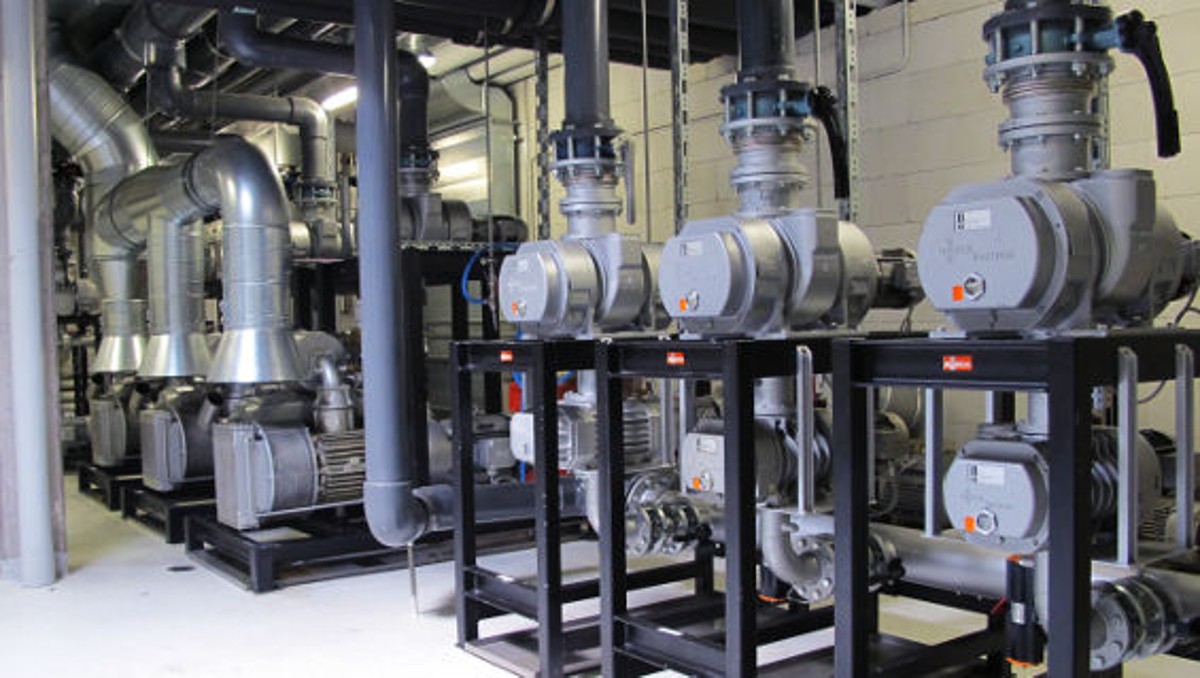
Central vacuum unit for the supply of vacuum to ten packaging lines at Schwarzwaldhof. Source: Busch Vacuum Solutions.
Vacuum-packed Black Forest specialities
Schwarzwaldhof Fleisch- und Wurstwaren GmbH
Schwarzwaldhof Fleisch- und Wurstwaren GmbH, based in Blumberg in the Black Forest, produces Black Forest ham and sausage specialities as well as various types of cured products. The unrivalled technical production, high quality of the ingredients used and sophisticated processing procedure guarantee outstanding Black Forest quality. Certification by the IFS (International Food Standard) and BRC (British Retail Consortium), as well as a number of awards in the form of DLG medals (Deutsche Landwirtschafts- Gesellschaft – German Agricultural Society) are another indication of the quality. Schwarzwaldhof also relies on top quality when it comes to the vacuum supply for their packaging lines, using a central unit from Dr.-Ing. K. Busch GmbH to generate the vacuum.
Schwarzwaldhof Fleisch- und Wurstwaren GmbH
Ham and sausage products have been produced in Blumberg since 1970. In 2007, the company Lutz Blumberg became Schwarzwaldhof Fleisch- und Wurstwaren GmbH. The product range comprises specialities made from Black Forest ham and cooked ham (pork shoulder). Schwarzwaldhof also produces snacks such as "Landjäger" (smoked sausage), "Pfefferbeisser" (pepperbites) and "Urige" (original), and ready cut Bologna sausage salad. Schwarzwaldhof makes products for the supermarket chain Edeka, both in the south west of Germany and the country as a whole, with export becoming increasingly important. There are a total of 250 employees working at the factory.Ham production process
For ham production, the meat pieces are rubbed with the special in-house salt mixture and left to mature for eight to ten days in a mother brine. The meat is placed in the cooking chamber for a further few days to reduce the moisture content, after which it is smoked over fir wood. It is then vacuum-packed as either a whole piece of ham or packaged as smaller consumer products.Until 2004, the vacuum supply was integrated directly into each packaging machine. As the operation grew, factory manager Bernd Goder contemplated removing the vacuum pumps from the production and packing areas in order to reduce noise emissions and to prevent the exhaust air from the vacuum pumps from coming into contact with the foodstuffs. He also wanted to avoid maintenance personnel carrying out maintenance work on the vacuum pumps in the production area, as this posed a risk to hygiene and interfered with the packaging process.
Central vacuum solution and its benefits for the customer
A new central vacuum unit was commissioned in 2004. This was designed and developed by the Busch vacuum specialists. Since then, the central vacuum unit has supplied all ten packaging lines, which are equipped with both thermoforming machines and rotary machines, and are used for vacuum packaging using protective gas (MAP) such as CO2 or N2. The central vacuum unit has a redundant structure, which significantly increases operational reliability as it prevents any performance losses in the event of a component failure.
After over eight years in operation, factory manager Bernd Goder is extremely satisfied with the central vacuum unit.
The Busch central vacuum unit offers a further significant advantage: it requires far less energy as a large amount of the required suction capacity is generated using PANDA roots vacuum pumps. Roots vacuum pumps generate the same suction capacity as rotary vane vacuum pumps with just one fifth or less of the energy, allowing considerable energy savings to be made.
During the first pump-down stage, the central vacuum is technically designed to generate a low vacuum of approx. 50 millibars in a vacuum buffer. The second stage involves reaching ultimate vacuum in another vacuum buffer, and this corresponds to the vacuum in the packaging.
By opening the main valve on the packaging chamber, the sealing chamber, which is under atmospheric pressure, is connected to the pre-evacuated buffer volumes and thus evacuated immediately. In terms of speed, this process is far superior to decentralised evacuation as pressure compensation takes place at nearly the speed of sound. This technique not only has the advantage of creating a production facility that is completely clean and silent, but also offers the greatest possible output from the packaging machines – regardless of how far away the vacuum generation is from the the packaging process.
Another part of the system maintains the vacuum for the moulding station on the thermoforming machines. A reserve pump is available in stand-by mode for when maintenance work is being carried out or if a vacuum pump were to break down. For factory manager Bernd Goder, the central vacuum supply from Busch is the most cost-effective and technically reliable solution.
By opening the main valve on the packaging chamber, the sealing chamber, which is under atmospheric pressure, is connected to the pre-evacuated buffer volumes and thus evacuated immediately. In terms of speed, this process is far superior to decentralised evacuation as pressure compensation takes place at nearly the speed of sound. This technique not only has the advantage of creating a production facility that is completely clean and silent, but also offers the greatest possible output from the packaging machines – regardless of how far away the vacuum generation is from the the packaging process.
Another part of the system maintains the vacuum for the moulding station on the thermoforming machines. A reserve pump is available in stand-by mode for when maintenance work is being carried out or if a vacuum pump were to break down. For factory manager Bernd Goder, the central vacuum supply from Busch is the most cost-effective and technically reliable solution.